NOTE: This was first published by CoverStory.ph on Oct.17, 2025.
Table of Contents
Sorsogon at the southernmost tip of the Bicol Peninsula usually draws local and foreign tourists to its coastal fringes. Among the top seaside destinations are Donsol and its whale sharks, Paguriran Island in Sorsogon City, Subic beaches in Matnog, and the surfing hubs in Gubat.
But there’s an alternative experience that visitors shouldn’t miss: a culinary tour of the province. If you have 72 hours to spend there, you may check out this route:
Donsol
An hour away by land from the Bicol International Airport in Daraga in neighboring Albay, Donsol used to boast kinunot na pating (shark) or pagi (stingray). Locals now also make kinunot out of the abundant fish tapas (smoked fish).
It is prohibited by law to catch sharks, especially for kinunot, but not stingrays. “Tapas are cheaper alternatives,” said municipal tourism officer Desiree Arbitria.
Kinunot is popular throughout Bicol. Its main ingredient from the marine bounty is shredded by hand and cooked in coconut milk. This dish won in the regional cook-off challenge, “Walang Gutom Kusinero” of the Department of Social Welfare and Development, early this year, and placed second in the national level of the same competition.
Fried kinunot na tapas are at times served by locals in lumpia wrappers and tied with tanglad (lemongrass).
A few minutes away by car from the town proper, Barangay Santa Cruz and its residents are proud of their tamisan or giant squid, which is sweet compared to the usual catch, hence the name.
Pilar
Chef Jocelyn Borja owns the Masbateños Eatery just outside Pilar Port, where they serve kusidong mamsa. The fish is abundant in Pilar during the cooler months from November to January, according to Shierra Totañes, the municipal tourism officer. But in Panlatuan Bay, which is about 10 minutes away from the port by boat, it is available from February to October, she said.
Kusido is like sinigang, except that calamansi, and not tamarind, is used as souring agent in its preparation.
“We learned how to cook it from our parents who started Masbateños Eatery,” Borja said as she constantly removed the impurities from the boiling mamsa broth before putting in three ladles of pure calamansi extract.
Chef Ranulfo Jadie Luzon serves Pilar Seafoods Express, which has a little bit of everything cooked in coconut milk: tahong (mussel), alimasag (crab), halaan (clam), hipon (shrimp), pugita (octopus), and baluko (penshell).
Sorsogon City
Speaking of baluko, your best destination to enjoy this is in Rompeolas, the baywalk park.
Baluko is often served cooked in coconut milk as guinatan, but it can also be served as sisig, or better yet, sisig wrap. Sometimes it is served in lumpia wrappers tied with tanglad leaves, and deep-fried to crisp perfection.
The province of Sorsogon is also the top producer of pili. While pili as a fruit is a well-known snack, its pulp is also a favorite among Bicolanos.
A linantang pili is enjoyed by letting the whole pili—together with the pulp—sit in warm or hot water. Once it is soft, it is best dipped in sugar, fish sauce, or soy sauce before eating.
Dropping in at the public market is a must. On the second floor are eateries offering breakfast and lunch. Eating there is a lot cheaper because the proprietors get their supplies, like the fish and meats, just downstairs, according to market supervisor Christian Sanchez.
Gubat
In the surfing town of Gubat, only one family makes timitim every day. And the Salvans’ house is just a stone’s throw away from the municipal hall.
Timitim is a delicacy made of steamed ground cassava layered with a mixture of eggs and coconut milk and topped with pili, cheese, corn, or jackfruit. It is best enjoyed while hot.
Lola Sayong’s beach resort serves all sorts of organic treats from tinapa pasta to buko juice shake.
Casiguran
Alimusan (marine catfish) is abundant in Casiguran. That’s why different villages here have found a way to serve it.
Aside from the usual grilled and ginataang alimusan, it is also served sweet and sour, kusido, sisig, picadillo (also cooked with coconut milk but with added tomato, ginger, onion, garlic, and sometimes chili), and parmesan-crusted.
Bulusan
The usual first stop in Bulusan is the tourism center just before you ride the electric carts to the Bulusan Volcano Natural Park (BVNP).
At the tourism center, visitors can buy pasalubong (trip gifts) like pili polvoron. The local brand PiliFinos is made by Gapas Delight Food, which employs indigenous folks from Bulusan.
Tourism officer Philip Bartilet says locals are proud of their heirloom dish kinagang, which is made with freshwater shrimp, chopped young coconut, and hand-shredded herba buena wrapped in a leaf of the indigenous hagikhik, or a banana leaf, before it is steamed and enjoyed with calamansi
Suso (freshwater snails) adobo can also be had in Bulusan. The best place to enjoy it in is the bee farm Balay Buhay sa Uma. Suso (tabagwang in other parts of Bicol) is cooked in coconut milk like any other Bicol dish. (The bee farm also serves the edible fern paco).
“It becomes tasty because it is made with love and passion by the people of Bulusan,” Bartilet said. “Aside from that, the ingredients are all fresh and the coconuts are delicious, maybe because the soil is rich here at Bulusan Volcano.”
He added: “The snails thrive in freshwater, like springs and rivers. Bulusan’s name is from ‘bulos,’ which means ‘where water flows.’ The water is from the BVNP, which we are taking care of. Our protection and conservation efforts bless us with tasty food.”
Kinaluko (kaluko in some parts of Bicol) is made from scraped taro meat mixed with young coconut meat and then sweetened with coconut milk. The mixture is put back inside the taro, which is then steamed with more coconut milk. Think of deviled eggs, but with taro.
Bulusan is also the biggest producer of pili in the whole of Bicol. Bartilet says 80% of the pili in the region comes from Bulusan.
Barcelona
The government-owned AgriHope is a place to learn about agriculture for many residents of the town of Barcelona.
Aside from growing herbs and spices, the learning center accredited by Tesda (or the Technical Education and Skills Development Authority) produces coconut vinegar, organic vegetables, and blue tarnates.
Close to the picturesque St. Joseph Parish Church is the café Curia, which serves bite-size pili cookies and pili breads, as well as fresh crab pasta.
Prieto Diaz
Rabbit fish, locally known as bataway, are dried into danggit by workers at the people’s organization-turned-cooperative Seamancor Eco-Developers Inc.
The group’s name is from “seagrass, mangroves, and corals,” all of which Prieto Diaz is blessed with.
Seamancor chair Joselito Domdom says Prieto Diaz has more than 800 hectares of seagrasses, where the rabbit fish are found. The fish is deboned and brushed, marinated in a brine solution for 30 minutes, and then sun-dried for one and a half days.
“You can find danggit at the public market, but we ran out during the recent town fiesta,” Domdom says, adding that rabbit fish can be caught a week before the new moon.
Irosin
Titania’s Catering in Barangay Gabao makes mochi-like nilupak or linupak (mashed cassava) alongside hinagom (ground glutinous rice cake) and cassava cakes.
Owner Claire Ayalin Ng said their nilupak was originally meant only as gifts to family friends. “Maybe they felt shy about always receiving gifts, so they said maybe they could just order instead. So I told my mom, okay, maybe we can make some money out of it,” she said.
The problem is that these snacks are not easy to make, and like any other reasonable business owner, Ng does not want to use low-quality ingredients. The boxes for her products are made from biodegradable materials and assembled by the women of her community whom she has hired.
Vicky’s Pili Products has its own culinary oil made from pili pulp and kernel, which is perfect with dried basil leaves for pesto. It also serves what it calls “3P Pasta”: Pili Pesto Penne Pasta.
Juban
Your last stop is Juban, which is proud of its clean buko (land snails). The snail is removed from its shell, and the liver removed. It is marinated in soy sauce, vinegar, and sugar before it is browned. It is further cooked in coconut milk and a lot of chili peppers, like the Bicol Express.
If land snails are not your thing, you can still enjoy a spicy tinutungan made of capiz (windowpane shell) cooked in kakang gata (or the first extract of coconut milk).
Every bite of a Sorsoganon dish carries a tale. Talk to a cook from any of these destinations and they will generously tell you stories of how they have kept their traditions alive.
Once you have tasted the sweetness of the delicacy, the freshness of the catch, the richness of the coconut extract, you have experienced culinary traditions that are preserved with care and love.
NOTE: Thanks for dropping by and reading this. If you want to be updated on the posts here, please subscribe to email alerts here. Please follow my Facebook page here and my YouTube channel here. Thank you and have a nice day!





